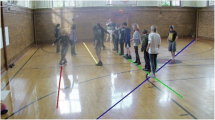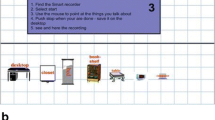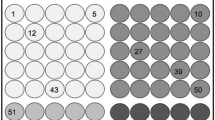Abstract
This paper offers a survey of body studies in mathematics education. Building on earlier insights about the ‘embodied mind’, which focused primarily on individual, intact bodies, we focus on recent work that elaborates bodies as distributed and extended and fully implicated in socio-material ecologies of learning. The aim of this article is to map current trends in this domain, and to articulate some of the current challenges. Because bodies matter differently depending on the research perspective, and because they are studied at multiple scales of mattering (neurological, sensory-gestural, affective, social, institutional, national, etc.), there tends to be disparate insights across the field with little to no cross-fertilization. This paper aims to open up conversations across different theoretical approaches—and scales of mattering—so as to create a more expansive and inclusive agenda for body studies in the field of mathematics education. We have chosen to organise our survey around five themes that seem dominant in the literature, where key theoretical and methodological trends can be discerned. These are: (1) groups, systems, ecologies (2) affect, movement, sensation, (3) language-use and gesture, (4) dis/ability and power, (5) technology, technicity, and tools. We argue that these different approaches need to be in conversation with each other, to think across research contexts, problems and communities, so that new forms of inquiry and new insights can emerge.
Similar content being viewed by others
Notes
The term ‘biosocial becoming’ is taken from the anthropologist Tim Ingold who attempts to capture an integrated approach to thinking the biological and the social, the organism and the context, phylogeny and ontogeny, being and becoming—thereby challenging the reductionisms of both sociobiology and cultural constructionism.
We are woefully aware of how this list is white and male. We are working to change that through the development of a new materialist philosophy of mathematics.
References
Abrahamson, D., Flood, V. J., Miele, J. A., & Siu, Y. (2018). Enactivism and ethnomethodological conversation analysis as tools for expanding universal design for learning: The case of visually impaired mathematics students. ZDM Mathematics Education. https://doi.org/10.1007/s11858-018-0998-1.
Abrahamson, D., Shayan, S., Bakker, A., & Van der Schaaf, M. F. (2016). Eye-tracking Piaget: Capturing the emergence of attentional anchors in the coordination of proportional motor action. Human Development, 58(4–5), 218–244.
Alibali, M., Nathan, M., Boncoddo, R., & Pier, E. (2019). Managing common ground in the classroom: teachers use gestures to support students’ contributions to classroom discourse. ZDM Mathematics Education. https://doi.org/10.1007/s11858-019-01043-x.
Ansari, D., & Lyons, I. M. (2016). Cognitive neuroscience and mathematics learning: How far have we come? Where do we need to go? ZDM Mathematics Education. https://doi.org/10.1007/s11858-016-0782-z.
Barad, K. (2007). Meeting the universe halfway: Quantum physics and the entanglement of matter and meaning. Durham: Duke University Press.
Bartolini Bussi, M., & Baccaglini-Frank, A. (2015). Geometry in early years: Sowing the seeds towards a mathematical definition of squares and rectangles. ZDM Mathematics Education, 47(3), 391–405.
Bartolini Bussi, M., & Mariotti, M. A. (2008). Semiotic mediation in the mathematics classroom: Artefacts and signs after a Vygotskian perspective, 2nd edn. In L. English, M. Bartolini Bussi, G. Jones, R. Lesh, & D. Tirosh (Eds.), Handbook of international research in mathematics education (pp. 720–749). Mahwah: Lawrence Erlbaum.
Baxter, J. A., Woodward, J., Voorhies, J., & Wong, J. (2002). We talk about it, but do they get it? Learning Disabilities Research & Practice, 17, 173–185.
Bernstein, B. (1996). Pedagogy, symbolic control and identity: Theory, research, critique. London: Taylor & Francis.
Bohlmann, N. (2018). Unequal bodies: Corporeality and social inequality in mathematics classrooms. ZDM Mathematics Education. https://doi.org/10.1007/s11858-018-1005-6.
Borgioli, G. M. (2008). A critical examination of learning disabilities in mathematics: Applying the lens of ableism. Journal of Thought, 43(12), 131–147.
Bugden, S., & Ansari, D. (2015). How can cognitive developmental neuroscience constrain our understanding of developmental dyscalculia? In S. Chinn (Ed.), International handbook of dyscalculia and mathematical learning difficulties (pp. 18–43). London: Routledge.
Butler, J. (1993). Bodies that matter: On the discursive limits of ‘sex’. New York: Routledge.
Chorney, S., & Sinclair, N. (2018). Fingers-on geometry: The emergence of symmetry in a primary school classroom with multi-touch dynamic geometry. In N. Calder, K. Larkin, & N. Sinclair (Eds.), Using mobile technologies in the teaching and learning of Mathematics. New York: Springer.
Chronaki, A. (2019). Affective bodying of mathematics, children and difference: choreographing ‘sad affects’ as affirmative politics in early mathematics teacher education. ZDM Mathematics Education. https://doi.org/10.1007/s11858-019-01045-9.
Coole, D. H., & Frost, S. (2010). New materialisms: Ontology, agency and politics. Durham: Duke University Press.
de Freitas, E. (2016a). Material encounters and media events: What (kind of mathematics) can a body do? Educational Studies in Mathematics, 91(2), 185–202.
de Freitas, E. (2016b). Karen Barad. In E. de Freitas & M. Walshaw (Eds.), Alternative theoretical frameworks for mathematics education research: Theory meets Data. Dordrecht: Springer.
de Freitas, E. (2016c). Mathematics education as a matter of the body. In M. Peters (Ed.), Encyclopedia of educational philosophy and theory. Singapore: Springer.
de Freitas, E., Ferrara, F., & Ferrari, G. (2018). The coordinated movements of collaborative mathematical tasks: the role of affect in transindividual sympathy. ZDM Mathematics Education. https://doi.org/10.1007/s11858-018-1007-4.
de Freitas, E., Lerman, S., & Parks, A. N. (2017a). Qualitative methods. In J. Cai (Ed.), Compendium for research in mathematics education. Reston: National Council of Teachers of Mathematics.
de Freitas, E., Sinclair, N., & Coles, A. (2017b). What is a mathematical concept?. New York: Cambridge University Press.
de Freitas, E., & Sinclair, N. (2013). New materialist ontologies in mathematics education: The body in/of mathematics. Educational Studies in Mathematics, 83(3), 453–470.
de Freitas, E., & Sinclair, N. (2014). Mathematics and the body: Material entanglements in the classroom. New York: Cambridge University Press.
de Freitas, E., & Sinclair, N. (2016). The cognitive labour of mathematics dis/ability: neurocognitive approaches to number sense. International Journal of Education Research, 79, 220–230.
De Smedt, B., & Grabner, R. (2016). Potential applications of cognitive neuroscience to mathematics education. ZDM Mathematics Education, 48(3), 249–253.
Dehaene, S. (2011). The number sense: How the mind creates mathematics. New York: Oxford University Press.
Deleuze, G. (1994). Difference and repetition. New York: Columbia University Press.
Deleuze, G., & Guattari, F. (1987). A thousand plateaus: Capitalism and schizophrenia. Minneapolis: University of Minnesota Press.
Drodge, E., & Reid, D. (2000). Embodied cognition and the mathematical emotional orientation. Mathematics Thinking and Learning, 2(4), 249–267.
Engeström, Y. (1987). Learning by expanding: An activity-theoretical approach to developmental research. Helsinki: Orienta-Konsultit.
Evans, J., Morgan, C., & Tsatsaroni, A. (2006). Discursive positioning and emotion in school mathematics practices. Educational Studies in Mathematics, 63(2), 209–226.
Fernandes, S. H. A. A., Healy, L., Martins, E. G., Rodrigues, M. A. S., & Souza, F. R. (2011). Ver e ouvir a Matemática com uma calculadora colorida e musical: estratégias para incluir aprendizes surdos e aprendizes cegos nas salas de aulas. In M. Pletsch & A. Damasceno (Eds.), Educação Especial e inclusão escolar: reflexões sobre o fazer pedagógico (pp. 97–111). Seropédica: EDUR.
Fuchs, L. S., Fuchs, D., Hamlett, C. L., & Appleton, A. C. (2002). Explicitly teaching for transfer: Effects on the mathematical problem-solving performance of students with mathematics disabilities. Learning Disabilities Research & Practice, 17, 90–106.
Gifford, S. (2006). Dyscalculia: Myths and models. Research in Mathematics Education, 8, 35–51.
Goldin, G. A. (2000). Affective pathways and representation in mathematical problem solving. Mathematical Thinking and Learning, 2(3), 209–219.
Goodwin, M. (2017). Haptic sociality. In C. Meyer, J. Streeck, & J. S. Jordan (Eds.), Intercorporeality: Emerging socialities in interaction (pp. 73–102). New York: Oxford University Press.
Grosz, E. (2005). Time travels: Feminism, nature, power. Durham: Duke University Press.
Gutiérrez, R. (2009). A “gap-gazing” fetish in mathematics education? Problematizing research on the achievement gap. Journal for Research on Mathematics Education, 39(4), 357–364.
Gutiérrez, R. (2017). Living mathematx: Towards a vision for the future. Philosophy of Mathematics Education Journal, 32(1), 2–26.
Hannula, M. S. (2012). Exploring new dimensions of mathematics-related affect: Embodied and social theories. Research in Mathematics Education, 14(2), 137–161.
Healy, L., & Fernandes, S. (2011). The role of gestures in the mathematical practices of those who do not see with their eyes. Educational Studies in Mathematics, 77(2–3), 157–174.
Healy, L., & Powell, A. (2013). Understanding and overcoming “disadvantage” in learning mathematics. In M. Clements, A. Bishop, C. Keitel, J. Kilpatrick, & F. Leung (Eds.), Third international handbook of mathematics education (pp. 69–100). New York: Springer.
Healy, L., & Sinclair, N. (2007). If this is your mathematics, what are your stories? International Journal of Computers for Mathematics Learning, 12, 3–21.
Herbel-Eisenmann, B., & Wagner, D. (2010). Appraising lexical bundles in mathematics classroom discourse: Obligation and choice. Educational Studies in Mathematics, 75(1), 43–63.
Hörl, E. (2017). Introduction to general ecology: The ecologisation of thinking. In E. Hörl & J. E. Burton (Eds.), General ecology: The new ecological paradigm (pp. 1–75). London: Bloomsbury.
Ingold, T., & Palsson, G. (2013). Biosocial becomings: Integrating the social and biological anthropology. Cambridge: Cambridge University Press.
Jewitt, C. (Ed.). (2009). The routledge handbook of multimodal analysis. London: Routledge.
Ladel, S., & Kortenkamp, U. (2016). Artifact-centric activity theory—a framework for the analysis of the design and use of virtual manipulatives. In P. S. Moyer-Packenham (Ed.), International perspectives on teaching and learning mathematics with virtual manipulatives (pp. 25–40). Dordrecht: Springer.
Lakoff, G., & Núñez, R. (2000). Where mathematics comes from: How the embodied mind brings mathematics into being. New York: Basic Books.
Lambert, R. (2019). Political, relational, and complexly embodied; experiencing disability in the mathematics classroom. ZDM Mathematics Education. https://doi.org/10.1007/s11858-019-01031-1.
Latour, B. (2005). Reassembling the social: An introduction to actor-network-theory. Oxford: Oxford University Press.
Lave, J. (1988). Cognition in practice: Mind, mathematics, and culture in everyday life. Cambridge: Cambridge University Press.
Lave, J., & Wenger, E. (1991). Situated learning: Legitimate peripheral participation. Cambridge: Cambridge University Press.
Lemke, J. (2000). Across the scales of time: Artifacts, activities, and meanings in ecosocial systems. Mind, Culture, and Activity, 7(4), 273–290.
Leont’ev, A. N. (1978). Activity, consciousness, and personality. New Jersey: Prentice-Hall.
Levin, M. (2018). What bodies think about: Bioelectric computation outside the nervous system, primitive cognition and synthetic morphology. Thirty-second Conference on Neural Information Processing Systems. https://nips.cc/Conferences/2018/Schedule?showParentSession=12528.
Lewis, K. E., & Lynn, D. M. (2018). An insider’s view of a mathematics learning disability: Compensating to gain access to fractions. Investigations in Mathematics Learning, 10(3), 159–172.
Martin, L. C., & Towers, J. (2015). Growing mathematical understanding through collective image making, collective image having, and collective property noticing. Educational studies in mathematics, 88, 3–18.
McLeod, D. B. (1992). Research on affect in mathematics education: A reconceptualization. In D. A. Grouws (Ed.), Handbook of research on mathematics learning and teaching (pp. 575–596). New York: MacMillan.
Merleau-Ponty, M. (2005). Phenomenology of perception. New York: Routledge.
Mikulan, P., & Sinclair, N. (2019). Stratigraphy as a method for studying the different modes of existence arising in the mathematical classroom. ZDM Mathematics Education. https://doi.org/10.1007/s11858-018-01018-4.
Nemirovsky, R., Kelton, M. L., & Rhodehamel, B. (2013). Playing mathematical instruments: Emerging perceptuomotor integration with an interactive mathematics exhibit. Journal for Research in Mathematics Education, 44(2), 372–415.
Nieder, A., & Dehaene, S. (2009). Representation of number in the brain. Annual Review of Neuroscience, 32(1), 185–208.
Noss, R., & Hoyles, C. (1996). Windows on mathematical meaning: Learning cultures and computers. Dordrecht: Kluwer Academic Press.
Nunes, T. (2004). Teaching mathematics to deaf children. London: Whurr Publishers.
O’Halloran, K. L. (2005). Mathematical discourse: Language, symbolism and visual images. London: Continuum.
Op’t Eynde, P., & Hannula, M. S. (2006). The case study of Frank. Educational Studies in Mathematics, 63(2), 123–129.
Papert, S. (1980). Mindstorms: Children, computers and powerful ideas. New York: Basic Books.
Papoulias, C., & Callard, F. (2010). Biology’s gift: interrogating the turn to affect. Body & Society, 16(1), 29–56.
Radford, L. (2014). Towards an embodied, cultural, and material conception of mathematics cognition. ZDM The International Journal on Mathematics Education, 46(3), 349–361.
Roth, W.-M. (2011). Geometry as objective science in elementary classrooms: Mathematics in the flesh. New York: Routledge.
Roth, W.-M., & Lee, Y. (2007). “Vygotsky’s neglected legacy”: Cultural–historical activity theory. Review of Educational Research, 77(2), 186–232.
Rotman, B. (2008). Becoming beside ourselves: The alphabet, ghosts, and distributed human beings. Durham: Duke University Press.
Sheets-Johnstone, M. (2012). Movement and mirror neurons: A challenging and choice conversation. Phenomenology and the Cognitive Sciences, 11(3), 385–401.
Siebers, T. (2008). Disability theory. Ann Arbor: University of Michigan Press.
Sinclair, N. (2016). Mathematics education as a matter of technology. In M. Peters (Ed.), Encyclopedia of educational philosophy and theory. Berlin: Springer.
Sinclair, N. (2019). Role of the sense in mathematical thinking and learning. In M. Peters (Ed.), Encyclopedia of educational philosophy and theory. Berlin: Springer.
Sinclair, N., & de Freitas, E. (2014). The haptic nature of gesture: Rethinking gesture with new multitouch digital technologies. Gesture, 14(3), 351–374.
Sinclair, N., & Heyd-Metzuyanim, E. (2014). Learning number with TouchCounts: The role of emotions and the body in mathematical communication. Technology, Knowledge and Learning, 19(1–2), 81–99.
Smythe, S., Hill, C., MacDonald, M., Dagenais, D., Sinclair, N., & Toohey, K. (2017). Disturbing boundaries in education and research. New York: Cambridge University Press.
Straehler-Pohl, H., & Gellert, U. (2013). Towards a Bernsteinian language of description for mathematics classroom discourse. British Journal of Sociology of Education, 34(3), 313–332.
Streeck, J., Goodwin, C., & LeBaron, C. (Eds.). (2011). Embodied interaction: Language and body in the material world. New York: Cambridge University Press.
Towers, J., & Martin, L. (2015). Enactivism and the study of collectivity. ZDM Mathematics Education, 47(2), 247–259.
Towers, J., Martin, L., & Heater, B. (2013). Teaching and learning mathematics in the collective. Journal of Mathematical Behavior, 32, 424–433.
Trouche, L. (2000). La parabole du gaucher et de la casserole à bec verseur: étude des processus d’apprentissage dans un environnement de calculatrices symboliques. Educational Studies in Mathematics, 41, 239–264.
Verillon, P., & Rabardel, P. (1995). Cognition and artifacts: a contribution to the study of though in relation to instrumented activity. European Journal of Psychology of Education, 10(1), 77–101.
Vogelstein, L., Brady, C., & Hall, R. (2019). Reenacting mathematical concepts found in large-scale dance performance can provide both material and method for ensemble learning. ZDM Mathematics Education. https://doi.org/10.1007/s11858-019-01030-2.
Vygotsky, L. S. (1978). Mind in society: The development of higher psychological processes. Cambridge: Harvard University Press.
Wilson, E. (2015). Gut feminism. Durham: Duke University Press.
Yackel, E., & Cobb, P. (1996). Sociomathematical norms, argumentation, and autonomy in mathematics. Journal for Research in Mathematics Education, 27(4), 458–477.
Yolcu, A., & Popkewitz, T. S. (2018). Making the able body: school mathematics as a cultural practice. ZDM Mathematics Education. https://doi.org/10.1007/s11858-018-1003-8.
Youdell, B., Harwood, V., & Lindley, M. (2018). Biological sciences, social sciences and the languages of stress. Discourse: Studies in the Cultural Politics of Education, 39(2), 219–241.
Zan, R., Brown, L., Evans, J., & Hannula, M. S. (2006). Affect in mathematics education: An introduction. Educational Studies in Mathematics, 63(2), 113–121.
Author information
Authors and Affiliations
Corresponding author
Additional information
Publisher's Note
Springer Nature remains neutral with regard to jurisdictional claims in published maps and institutional affiliations.
Rights and permissions
About this article
Cite this article
Sinclair, N., de Freitas, E. Body studies in mathematics education: diverse scales of mattering. ZDM Mathematics Education 51, 227–237 (2019). https://doi.org/10.1007/s11858-019-01052-w
Accepted:
Published:
Issue Date:
DOI: https://doi.org/10.1007/s11858-019-01052-w




